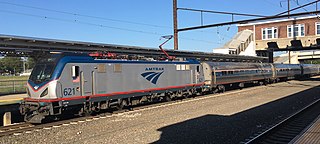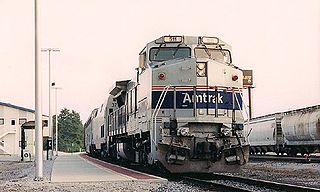
The Keystone Service is a 195 mile regional passenger train service from Amtrak between the Harrisburg Transportation Center in Harrisburg, Pennsylvania, and 30th Street Station in Philadelphia, running along the Philadelphia to Harrisburg Main Line. Most trains continue along the Northeast Corridor (NEC) to Penn Station in New York City.

The Lake Shore Limited is an overnight passenger train operated by Amtrak between Chicago and the Northeastern United States, with sections to New York City and Boston. The central segment of the route runs along the southern shore of Lake Erie.

Michigan Services are three Amtrak passenger rail routes connecting Chicago, Illinois with the Michigan cities of Grand Rapids, Port Huron, and Pontiac, and stations en route. The group falls under the Amtrak Midwest brand and is a component of the Midwest Regional Rail Initiative.

Commuter rail services in the United States, Canada, Cuba, Mexico, Panama, and Costa Rica provide common carrier passenger transportation along railway tracks, with scheduled service on fixed routes on a non-reservation basis, primarily for short-distance (local) travel between a central business district and adjacent suburbs and regional travel between cities of a conurbation. It does not include rapid transit or light rail service.

The Michigan Central Railroad was originally chartered in 1832 to establish rail service between Detroit, Michigan, and St. Joseph, Michigan. The railroad later operated in the states of Michigan, Indiana, and Illinois in the United States and the province of Ontario in Canada. After about 1867 the railroad was controlled by the New York Central Railroad, which later became part of Penn Central and then Conrail. After the 1998 Conrail breakup, Norfolk Southern Railway now owns much of the former Michigan Central trackage.

The Kentucky Cardinal was a nightly 312-mile (502 km) passenger train operated by Amtrak from 1999 to 2003 between Chicago, Illinois, and Louisville, Kentucky, via Indianapolis, Indiana. On the three days that the Cardinal ran, the Kentucky Cardinal operated as a section, splitting at Indianapolis. On the other four days, it ran on its own to Chicago.

The Calumet, also commonly called the Valpo Local, was a 43.6-mile (70.2 km) passenger train route operated by Amtrak between Chicago and Valparaiso, Indiana. Despite Amtrak's mandate to provide only intercity service, the Calumet was a commuter train. Transferred from Conrail in 1979, the full route was shared with Amtrak's Broadway Limited until 1990; the Calumet was discontinued the next year.

The International was a named passenger train operated between Chicago and Toronto. It was originally an overnight train operated by the Grand Trunk Railway of Canada and its successors the Canadian National Railway and Grand Trunk Western Railroad, running as far as Montreal. The train was cut back to Port Huron, Michigan, in 1970 and discontinued in 1971.

The Wolverine is a higher-speed passenger train service operated by Amtrak as part of its Michigan Services. The 304-mile (489 km) line provides three daily round-trips between Chicago and Pontiac, Michigan, via Ann Arbor and Detroit. It carries a heritage train name descended from the New York Central.

The Blue Water is a higher-speed passenger train service operated by Amtrak as part of its Michigan Services. The 319-mile (513 km) route runs from Chicago, Illinois, to Port Huron in Michigan's Blue Water Area, for which the train is named. Major stops are in Kalamazoo, Battle Creek, East Lansing, and Flint.

Ann Arbor station is a train station in Ann Arbor, Michigan, United States that is served by Amtrak's Wolverine, which runs three times daily in each direction between Chicago, Illinois and Pontiac, Michigan, via Detroit.

Hammond–Whiting station is an Amtrak intercity train station in Hammond, Indiana. The station is along the former Pennsylvania Railroad Fort Wayne Line, now owned by Norfolk Southern Railway. North of the station lies the former Baltimore and Ohio and Elgin, Joliet and Eastern Railroad tracks. The station building and parking lot lies on the former New York Central Railroad mainline. Hammond–Whiting opened on September 11, 1982. Until the early 2000s, it was served by all Amtrak service that ran east from Chicago; today, it is only served by two daily Wolverine round trips.

Railroads have been vital in the history of the population and trade of rough and finished goods in the state of Michigan. While some coastal settlements had previously existed, the population, commercial, and industrial growth of the state further bloomed with the establishment of the railroad.

Ann Arbor–Detroit Regional Rail is a proposed commuter rail service along the Michigan Line between the cities of Ann Arbor and Detroit, Michigan, a total length of 39.72 miles (63.92 km). The project would connect with a proposed Detroit bus rapid transit service and the QLine streetcar.
WALLY was a commuter rail service proposed in 2008 which would have linked the Michigan cities of Ann Arbor and Howell. It never got past the planning stages.

The James Whitcomb Riley was a passenger train that operated between Chicago, Illinois, and Cincinnati, Ohio, via Indianapolis, Indiana. Originally operated by the New York Central Railroad, it was taken over by Amtrak in 1971. Under Amtrak, it merged with the Chesapeake & Ohio Railway's George Washington to become a Chicago-Washington/Newport News train. In 1977, it was renamed the Cardinal, which remains in operation.

The New England States was a passenger train operated by the New York Central Railroad and its successor Penn Central over the Water Level Route between Chicago and Boston. It was launched in 1938, in tandem with the relaunch of the newly-streamlined 20th Century Limited, and assumed responsibility for that train's Boston sleepers. In 1949 it became the first Chicago–Boston streamliner. The New York Central dropped the name in 1967; an unnamed remnant continued running until 1971. Amtrak's Lake Shore Limited now serves the route.

The Mountaineer was a passenger train operated by Amtrak between Norfolk, Virginia, and Chicago, Illinois, via Cincinnati, Ohio. It was the first train to use the Norfolk and Western Railway's tracks since the creation of Amtrak in 1971 and followed the route of the Pocahontas, the N&W's last passenger train. Service began in 1975 and ended in 1977. A new train, the Hilltopper, operated over much of the Mountaineer's route but was itself discontinued in 1979.

The Twilight Limited was a named passenger train in the United States which initially operated between Chicago, Illinois, and Detroit, Michigan. The New York Central Railroad introduced the train in 1926, and it continued until the formation of Amtrak in 1971, although it lost its name in 1967. Amtrak renamed the train St. Clair, feeling that the name "Twilight Limited" had undesirable connotations and imagery for a company trying to save passenger rail service. Amtrak revived the name in 1976 for a new train frequency on the Chicago–Detroit corridor, and kept the name until all trains on that corridor were renamed Wolverine in 2004.

SEMTA Commuter Rail, also known as the Silver Streak, was a commuter train operated by the Southeastern Michigan Transportation Authority (SEMTA) and the Grand Trunk Western Railroad between Detroit and Pontiac, Michigan. It began in 1974 when SEMTA assumed control of the Grand Trunk's existing commuter trains over the route. SEMTA discontinued operations in 1983. Amtrak began offering intercity service between Detroit and Pontiac in 1994 as part of its Michigan Services.




















